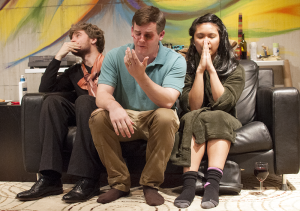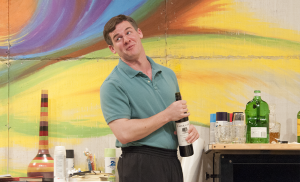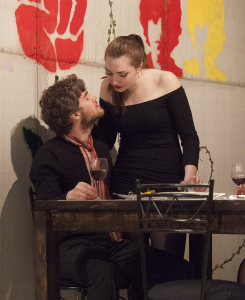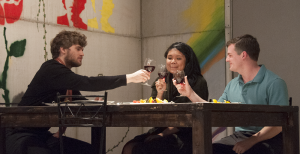
Conor Canning (COL ’16), Greg Keiser (COL ’16) and Cristina Ibarra (COL ’17) play Eduardo, Alfred and Melinda in the Nomadic Theatre’s “Happy.”
As its title implies, the Nomadic Theatre’s latest production deconstructs the definition of happiness, stripping it down to its rawest form. Directed by Alice Neave (COL ’16) and produced by Velani Dibba (SFS ’17), “Happy” shows that true happiness bears little similarity to the facade that is often presented on its surface.
The show is “a comedy until it stops being a comedy,” playwright Robert Caisley said in the program notes. Initially, the audience is lulled into a false sense of ease from the frivolously crude humor of the opening scene where Eva — played by Kate Ginna (COL ’18) — clad in only a bath towel, harasses Alfred — played by Greg Keiser (COL ’16) — making him deeply uncomfortable. Yet, within the first few moments, the mood abruptly shifts when Eva spontaneously inserts tragic details about her life and describes the suicide of her little brother and the abuse she suffered from her ex-lover.

The juxtaposition of such poignant topics with Eva’s breaking of basic social norms leaves the audience bewildered in a whirlwind of emotions including disbelief, humor and sadness.
The two initial characters are strikingly distinct. Eva is the eccentric, unstable, wild lover of Alfred’s childhood friend, Eduardo — played by Conor Canning (COL ’16). Alfred is seemingly very ordinary, with an ordinary job and wife and daughter. As Eva tells Alfred, Eduardo described him as “a cheery f—er,” leading Alfred to question the meaning of being, as Eduardo would say, “freakishly happy.”
Neave said that it was important for the cast and crew to pay attention to the detailed use of language in the play.
“I was really drawn to how important language is in the play and how it kind of is about how language can be used as a weapon — it’s not really about what you say, but about how you phrase it,” Neave said.

Eva offers her own insight into what it means to be happy as she says, “I don’t trust happy people. I think they’re phony. They’re lying to themselves and everyone around them. I only trust unhappy people — authentic people.” When Alfred points out that Eduardo is happy from the recent birth of his grandchild and the gain in respect in his field of work, Eva retorts that: “That’s not happy.”
The entire play oscillates between a very precarious balance of solemnity and light-heartedness. At the first sign of a grave conversation, a spontaneous line or introduction of a new character slices through the tension like a blade, preventing the plot from becoming too bogged down. For instance, Eduardo’s entrance is loud and appropriately timed. His character embodies the stereotypical creative artistic genius, and his entrance unquestionably depicts his large personality. This stark contrast between him and Eva with Alfred and his wife Melinda — played by Cristina Ibarra (COL ’17) — offers a clear dichotomy between transparent authenticity and the facade of happiness.
Eva’s two metal sculptures made out of scrap pieces of junk are integral parts of the plot and set. As Canning explained: “The subject is happiness. She’s trying to locate where in the body it can be found because it is rarely found other than in the face.” Not long after this quest for discovering true happiness is proclaimed, the previously “freakishly happy” Alfred’s rapid deterioration and stripping of his perfectly happy external demeanor begins to unfold.
According to Neave, the main characters’ qualities are realistic.
“I’m really interested in shows that say something new about human nature and look at this really raw element of ourselves that we keep under the surface,” Neave said. Eva is a character and Alfred is a character that you know are such archetypes of people that we see. I think we each have an Eva and Alfred in our own lives.”
As Dibba said about Nomadic Theatre: “Our sort of catch phrase is ‘socially engaging, technically ambitious.’” The production of “Happy” is clearly no exception, as one of the most striking aspects of the production is in the technical details of the set. From the beautiful mural of bright swirls of color with stencil detailing on the walls to the hand-crafted table with stained wood, the artistic creativity and originality of the Nomadic Theatre that went into imagining, designing and constructing these pieces are remarkable.

As the play’s technical director, Nora Welsh (COL ’16), said: “The stage itself is like a work of art.” Not only is the art an integral part of the setting and backdrop, but it also acts as an active prop in the play. One particularly notable example is the shattering of the metal sculpture that highlights the technical ingenuity required for this production.
Every action in the play is captivating, stimulating all the senses and evoking all the emotions. The angry blows thrown, a passionate kiss, an emotional cutting of hair, the smell of cigarette smoke — each of these sensual experiences adds a new dimension to the show that allows for a continual, dynamic journey between the audience and cast. The reverse-thrust stage, where the stage and acting extends into the audience on all three sides, contributes further to this interconnectedness.
With only four actors in the cast, the play is largely text-focused. Neave said that this was one of the most appealing aspects of “Happy.”
“I think that this show is so much about the people interacting with each other, so much about the interplay between the actors,” Neave said. “And I think that is so rare to find a play that focuses primarily on that.”
“Happy” runs from April 8 to 9 and 13 to 16 in the Walsh Black Box Theatre.



















